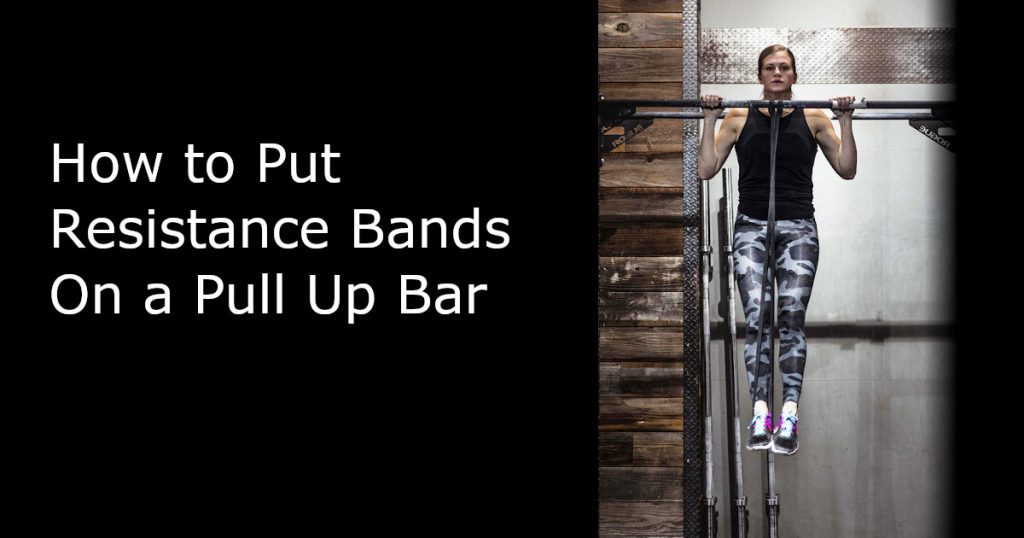Putting resistance bands on a pull-up bar can be simple and easy with a few basic rules. Let us walk you through how to do this in this article along with providing some simple tips and pointers.
Contents
Steps to put a resistance band on a pull up bar:
Step 1 – Choose Your Resistance Band

This may not be the most important step, but it is always the first. You have to choose a band that will offer the right resistance for your wait and skill level. Use the manufacturers metrics to gauge the weight of the band you will use and try to estimate that as the amount of weight you will be removing when using them to assist you. Note that it is generally easier to use a band that you don’t need to tie, but if you only have access to that type, don’t fret we will show you how to still use these below.
Generally orange has the least resistance, red has a medium degree of resistance, and the most resistance is provided by blue and green. If you are a novice, begin with blue or green.
Step 2 – Setup Your Band on the Bar
Continous Loop Band
Pull the loop of the band over the top of the bar and push the other end of the band loop through the loop you pulled over the top. Pull that loop through so there is a cinch loop at the top of the bar with an opening for your foot at the bottom
Single Tie Band
Lace around the bar on both ends of the resistance band, and tie each in a secure knot. Test the band by pulling it down to make sure it is safe. A number of knots work here, including tying a loop first and then using the technique above as if you already had a continuous loop band.
Step 3 – Execute your exercise routine

Bring the middle of the dominant foot into the bottom of the band after that. Bend the non-working leg slightly and cross it behind the dominant leg.
In an overhand grip, keep the pull-up bar, hands spread slightly wider than the arm’s width. If you are not able to hit the pole, balance on a chair or exercise box. Slide down your back with your shoulder blades and engage your abdominal muscles.
Brace your glutes and pelvis so that during the workout, the body remains stable and rigid. As your elbows are bent and pointed toward the concrete, raise your head toward the counter. Try to clear the bar with your chin.
Slowly lower your body, straighten your arms and return to the starting spot. Use the strength of the band to execute the subsequent repetitions immediately. In this exercise, the goal is to finish five to eight reps.
Why do we use resistance bands on pull up bars?
Banded pull-ups are generally good for you when you are practicing and trying to get stronger. It supports you so that you can bring the bar to the chin or chest. Banded pull-ups are inexpensive alternatives to gym machines that give a counterweight to the one exercising the legs or knees.
Resistance bands simulate pull-ups by effectively reinforcing the involvement of muscles. Doing this will allow you to crush pull-ups on a bar eventually. Through the simple movement of pulling yourself up to the pull-up bar, pull-ups can engage and strengthen almost your entire upper body.
It is a highly functional pattern of movement that demands that several classes of muscles operate together. If you are like most of us, you will most likely appreciate a little pull-up help through resistance bands to get you going. To help you know better about resistance bands, we have prepared the step by step process on how you can put these on your pull up bars alongside some exercises that involve it.
Top 3 Exercises with Resistance Bands on Pull Up Bars
1. Assisted Pull-Ups
Your whole upper body, including your arms, shoulders, and core, helps for pull-ups. The majority of the beginners find a complete pull up tricky. The best way you can create the starting power to do an unassisted pull up by adding a pull-up band to your pull-up bar.
Loop one end of your resistance band around your bar first. In both hands, take the bar and put either your knee in the band or your foot. During the workout, the band now helps you.
Complete the pull-ups precisely as you usually do. When completing this exercise, the heavier the resistance band, the more support you can get.
2. Human Flag
One of the most successful core-stabilizing exercises is the human flag, which can help you get a shredded, muscular six-pack and firm stomach. When practicing the human flag, the purpose of using resistance bands is to build the muscles you need to perform this exercise unsupported.
Next, circle around the top of your bar with your resistance band. If your home gym has them, you can hang the bar next to a vertical post, trees, or wall rungs. Hook one foot into the band’s dangling end, then get into the role of the human flag.
With a proper grip, grab the pole or wall plays, and concentrate on moving your bottom shoulder forward while engaging and bringing your upper shoulder back.
3. One-arm Pull-Ups
The one-arm pull-up is a very tough exercise. Around the pull-up rope, loop the resistance band. To execute this variation, grip the pull-bar with one hand only and pull your shoulder blade downwards to get in line.
Then, bend your arm and raise yourself while pushing the pull-up band on your other arm. It helps to force the other arm to the stage at which you hit the pull-bar or move it.
What are the best resistance bands to use for pull-ups?
There are several brands of resistance bands available in the market. Each one may vary in length, design, and resistance level. With the several options available, we understand that choosing one can be overwhelming.
If you want to know more about these resistance bands and narrow down your options, you may visit this article for the best types of resistance bands available. It will help if you weigh your options and match them according to your needs and preference.
Conclusion
Whether you are a beginner in trying pull-ups or a professional who wants to level up your game, resistance bands are an excellent way to help you improve your strength. With continued practice, you will eventually find yourself getting more robust and perform some of the most challenging routines without assistance. Consider following the steps above, including the exercises we suggested to start.



how to keep stable without swinging with resistance band on pull up bar?